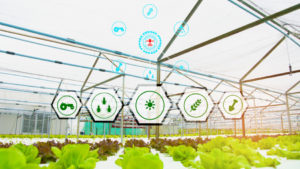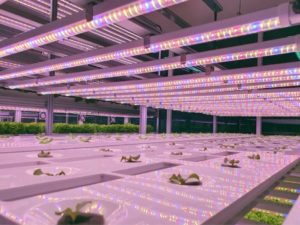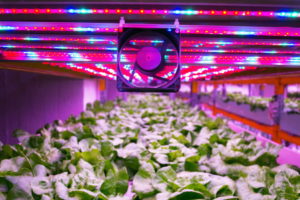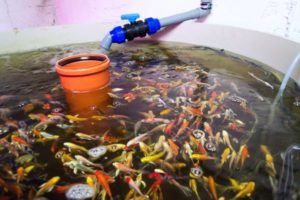
Vertical farming is an increasingly popular technique of producing crops indoors in a vertical setting. A vertical system involves the cultivation of crops in controlled environments, where every parameter affecting their growth is closely monitored and tailored to their needs.
The concept of controlled environment agriculture underpins vertical farming as cutting-edge technologies are utilized to provide adequate conditions for any crop. With the use of new technologies like AI, ML, and IoT, vertical farming is poised to reach new heights.
Vertical farming can be explained most effectively by understanding the technologies that make it possible. Below, we’ll explore how controlled environment agriculture works, how different parameters are controlled, and how new technologies like AI, ML, and IoT are driving innovation in indoor crop production.
Before we dive in, if you are looking to get started growing your own crops from the comfort of inside your home, I want to recommend this complete kit so you can start growing within just a couple of weeks!
Controlled Environment Agriculture (CEA)
Controlled environment agriculture is fundamentally at the heart of vertical farming since it integrates several technologies in order to provide plants with the best environmental and growth conditions during their growth. By using a controlled environment system, vertical farming can grow fresh, pest-free crops all year round. In vertical farms plants are isolated from the outside environment, and workers take preventive measures to prevent pest infestations that could damage the crops. Although controlled environment systems are commonly associated with vertical farming, they can be used by horizontal farming as well.
Vertical farms use smart sensors to monitor technical variables including temperature, carbon dioxide, oxygen, lighting, humidity, nutrient concentration, pH, pest control, irrigation, and harvesting. Typically, controlled environments involve hydroponic, aeroponic, or aquatic cultivation. Moreover, controlled environment agriculture can utilize advanced imaging and sensor technologies including cameras and thermal imaging to measure plant growth, temperature, and other factors. Presently, controlled environment systems have proven highly effective in growing leafy greens, herbs, microgreens, and vegetables such as tomatoes, peppers, melons, and sweet corn.
Controlled Environment Components
Dosing systems
A common approach in vertical farming is to use an automated-dosing system to deliver nutrients to the plants and monitor the nutrient solution. Automatic-dosing systems continuously assess the reservoir’s nutrient concentrations, pH and EC levels, and water temperature. In most instances, the dosing system is connected to the nutrient source by peristaltic pumps that suck the required dose of nutrients and dispense them into the reservoir.
Probes placed in the reservoir measure pH and EC in real-time, then restart the dosing cycle when necessary. Having an automated dosing system enables growers to have more control over the nutrient solution without having to spend much time fixing pH, EC, nutrients, and temperatures. Additionally, plants are supplied with a precise amount of nutrients, avoiding plant shock or stunted growth, which are often a consequence of imbalanced growing conditions.
Sterilization Systems
Sanitation is necessary for the optimal growth of plants and to guarantee compliance with international food safety regulations. To ensure the production of pesticide-free crops all year round, vertical farming practices rigorous sterilization and disinfection strategies. Sterilization can be accomplished using several methods however the most commonly used ones include chemical disinfection, UV-C sterilization, and ozone sanitation.
Chemical disinfection
Chemicals such as hypochlorite and hydrogen peroxide help to sterilize surfaces like floors, transporting equipment, and tools such as harvesting clippers, that if not cleaned can easily spread diseases from plant to plant.
UV sterilization
Sterilization using UV emitting lights is a chemical-free technique for destroying various types of microorganisms, including bacteria, fungi, and viruses. This is one of the most effective methods of sterilization since it kills about 99.9% of all microbes in the treated area. Vertical farms most commonly use UV-C for sterilization.
Ozone Sanitation
In this method, the ozone gas, which is ubiquitous in the atmosphere and on the ground, is utilized to clean the air in indoor farms. High levels of ozone gas have been proven effective at killing fungi and microorganisms.
Recapturing water from moist
The average vertical farm that utilizes hydroponic, aeroponic, and aquaponic growing methods uses 95 percent less water than horizontal farms. Additionally, many vertical farms reduce their water use by recapturing and recycling irrigation water. Plants generally lose most of the water they are provided with during the process of transpiration, and some vertical farms collect this water using dehumidifiers and air conditioning. After being filtered, and treated the captured water is reused in the production process.
Lighting
In indoor farming, the natural light is replaced by artificial lighting, which serves as the crop’s sole source of illumination. The color, intensity, and duration of light all have an impact on plant growth and yield. In vertical farming, a great deal of research goes into selecting the best performing light source since every stage of plant development has different lighting requirements.
Many lighting companies provide light formulations to vertical farmers, helping them maximize their yields. One example is the AP673L range offered by a Finnish lighting company, “Valoya“, which is specifically designed to increase biomass production, as well as enhance the flavor. There are currently three types of grow lights in indoor agriculture: fluorescent grow lights, high-pressure sodium lights (HPS), and LED lights.
Fluorescent grow lights
Fluorescent grow lights are typically used in vertical farming to grow leafy greens and vegetables. Light is produced by passing energy through a gas in a tube, and it can be divided into two categories: tubular grow lights and compact fluorescent lights.
Tubular grow lights
In addition to their wide range of shapes, forms, and intensities, fluorescent lights also provide a wide range of color temperatures from 2,700K to 10,000K. Moreover, they come in thin shapes, which allow them to be easily integrated into smaller spaces, and they have a long light life of between 12,000 and 20,000 hours. Despite this, fluorescent lights are expensive to repair, require a ballast, contain mercury, and gradually lose efficiency.
Compact fluorescent lights
Unlike traditional fluorescent lights, compact fluorescent lights (CFLs) produce less heat, are highly efficient, and do not require a ballast to function. Specifically designed for indoor farming, these lamps are also the cheapest of the three main lighting options used in vertical farming. Nevertheless, CFLs are characterized by low light intensity, which affects plant growth. Additionally, they contain small amounts of mercury, and their quality declines over time.

The Farmstand Is Your Self-Watering, Self-Fertilizing Solution for an Easy to Grow Harvest
HPS – High-Pressure Sodium Lights
The sodium lights, or HPS as they are commonly known, were developed for street lighting in the 1950s. They are a type of gas discharge light (HID). According to The Edison Tech Center, an HPS lamp is composed of an aluminum oxide arc tube containing sodium, mercury, and xenon.
In vertical farming, HPS grow lights are very popular since they emit mostly Red (45%) and Green light (52%), both of which are essential to promote flowering and fruiting. In contrast, HPS grow lights lack Blue light (3%), which could slow plant growth during the early stages of development and result in low yields. Additionally, HPS lights emit a lot of heat, contain mercury, and have a poor color rendering index of 24, which makes the visual monitoring of the plants challenging.
LED lighting
LEDs were first utilized for growing plants indoors by NASA and are rapidly becoming the first choice of lighting for many vertical farms across the globe. The Canadian vertical farm “GoodLeaf” ditched its old lighting system in favor of an LED one. LED lamps produce light when an electric current passes through a semiconductor, which emits that light through the process of electroluminescence. A wide range of crops is grown indoors with LED lights, including leafy greens, tomatoes, and herbs.
But why are LED lights so popular in vertical farming? There are a couple of reasons for this. Firstly, LED lights generate less heat than HPS grow lights, which allow growers to place them closer to their crops, maximizing space. Secondly, they have a long life because they rarely fail, however, their brightness gradually diminishes over time. A major advantage of LED lights is that they consume 85% less energy than traditional incandescent bulbs, thus reducing energy-related costs in vertical farming.

Air control
CO2 enrichment
The ideal CO2 concentration for indoor farming is estimated to be around 1000 parts per million, however, these levels can easily fall below 800 parts per million during ventilation and photosynthesis. Carbon dioxide is a crucial element for the photosynthesis process, and even the slightest variations in its concentration directly affect plant growth and productivity. It has been reported that CO2 enrichment promotes rapid plant growth and increases plant productivity. There are many different kinds of CO2 enrichment techniques available, ranging from traditional low-tech to high-tech sensor-based ones.
CO2 gassing
This conventional technique produces CO2 by burning propane or natural gas using carbon dioxide burners. HVAC systems control the CO2 airflow, ensuring an even distribution of the gas into the growing area.
Compressed CO2
This technique involves the transformation of compressed CO2 from its liquid state into its gas state and injecting the gas into the growing chamber over a time period. The gas pressure is reduced using a pressure regulator.
Misting aqueous CO2 by CO2 Delivery Solutions
One of the most sophisticated and cost-effective CO2 enrichment methods, as it supplies CO2 directly into plant leaves. According to the website of CO2 Delivery Solutions in this method, CO2 is injected into a CO2 infusion system, which dissolves the gas and saturates the water. After the CO2 solution is saturated, it is misted directly as microdroplets onto the plant’s leaves via an overhead misting system. The method reduces the amount of CO2 used and the additional costs incurred from CO2 enrichment because it does not require additional equipment such as HVAC systems.
Airflow
For plants to grow properly, a vertical farm must have constant airflow. The airflow in vertical systems movies the air through the filtering systems, reduces humidity, removes heat, and circulates CO2. The build-up of heat and humidity in the growing area makes it a perfect breeding ground for bacteria, fungi, and mold, thus increasing the risk of infection. According to a ZipGrow article, the layout of an indoor farm also plays a crucial role in the air movement within the facility. Vertical farming systems, for instance, use vertical planes that allow the air to move easier than in horizontal layouts.

Moreover, different airflow monitoring systems have been developed, such as the one by Kanomax. This system uses airflow transducers, which are located close to the farm’s entrance and exit points, and measure air velocity 24/7 using a hot-wire system that transmits the data to a terminal. This allows growers to intervene in real-time if the airflow is too poor or excessive in a vertical farm.
Air humidity
When cultivating plants indoors, humidity is a significant factor to consider, as it indicates the amount of water vapor in the air. Typically, most crops thrive when humidity levels are between 40% and 50%, and they struggle when they fluctuate. Low levels of humidity stunt plant growth and reduce the quality of produce, while high levels result in bolting, reduced yields, and quality. A very high level of humidity can lead to fungi growth, which could result in complete crop loss if not treated immediately.
Water vapor is released when plants transpire and can build up in the growing environment of indoor farms, leading to increased humidity. Vertical farms rely on dehumidifiers and dehumidification systems to maintain their humidity levels in check. Dehumidification systems remove excess moisture from the growing environment, in order to control its relative humidity and dew point. Moreover, Dutch researchers developed a dehumidification system that avoids excess evaporation into the air. By recycling their own water and natural humidity, vertical farms can conserve about 10% more water than traditional farming.
The Internet of Things – IoT
IoT is already used in the agricultural sector to boost yield, monitor crops at any given time, and make farming more efficient. IoT enables vertical farming to control the growth environment under which crops are cultivated, as the employed smart sensors measure every detail from humidity to pH levels and transmit them to the growers in real-time.
Sensors
Sensors are the backbone of IoT as they measure physical input such as heat, illumination, humidity, etc., convert it into data, and send it to the central cloud, where either machines or humans interpret it. An extensive network of IoT sensors is used in vertical farms, including CO2 sensors for monitoring and maintaining optimal CO2 levels, especially in the growing chamber and temperature sensors that measure light intensity and outside temperature. Other popular sensors include humidity sensors, pH sensors, EC sensors, magnetometer sensors, air quality sensors, etc.
Image processing for evaluating plants’ health and maturity
To monitor the health and growth of their crops, vertical farms also use image processing software and sensors. These programs are used to monitor pest damage, measure the content of macroelements such as nitrogen, and detect developmental defects. For instance, with the help of hyperspectral imaging, “Agricola Moderna” an Italian vertical farm has been able to extract critical information about the presence of macroelements in their crops such as nitrogen and phosphorous. In plants, these macroelements are great indicators of plant health.
Data collected by in-situ sensors is transmitted in real-time to a central server where artificial intelligence and machine learning can be applied to analyze the data. This enables growers to make the most of their data, identify patterns, and troubleshoot any problems in record time.
Vertical Layout of Farms
Unlike outdoor agriculture, horizontal indoor farming involves planting crops in rows. Typically found in greenhouses, this type of arrangement occupies a lot of space. By contrast, in vertical systems, crops are planted in vertical tubes and are stacked on top of each other using vertical racks. Growing plants vertically gives farmers the ability to grow more crops in a smaller area, enabling them to maximize the available space and increase yield per square foot of land. Moreover, various technology companies are driving innovation in the field of vertical farming by building racks that use less space and maximize space.
As an alternative to soil-based growing methods normally found in horizontal farming, vertical farms employ hydroponic, aquaponic, and aeroponic techniques. Plants are provided with physical support by growing media such as clay pellets, perlite, coconut coir, Rockwool, and oasis cubes. An efficient system of pipes, tubes, and pumps delivers water and nutrients directly to the roots of the plants. Moreover, this system also captures excess water and recirculates it again to the plants.
Another growing method in vertical systems is aquaponics, which combines hydroponics with aquaculture to produce fresh plants and fish. In this method plants are grown in growing media and supplied with water and nutrients from the fish tank. This system also does not require fertilizers and fish waste is broken down by bacteria and dissolved into plant essential nutrients like nitrogen and phosphorus.

Nurseries and Systems for Growing Seedlings
Traditional farming has always used plant nurseries to improve crop uniformity, shorten the growing season, and increase crop yields. Vertical farms often use plants nurseries to start seeds as well. Typically, the seeds are planted in Rockwool plugs, watered, and then placed in nursery rooms, which are equipped with LED grow lights and the climatic conditions are tailored according to the seeds’ needs. Seedlings are transplanted from the Rockwool plugs to the vertical racks once their roots reach the bottom of the plugs.
Moreover, nurseries are in vertical systems allow growers to predict the harvest date of their crops more accurately and to dynamically maximize space as well. According to recent research, growing leafy greens like butterhead lettuce in nurseries with LED lights increases plant weight by about 56 grams compared to growing them in the sun. Nurseries also allow vertical farms to grow more than one type of crop at a time.
However, transplanting crops from plant nurseries into the main growing systems comes with a few disadvantages as well such as increased labor costs, and possible transplant shock which can impede plant growth. Additionally, it is reported that plant roots often adhere to the growing medium, which can damage the root system.
Would you like to get your own crops growing at home, right from the comfort of your kitchen? I can recommend this kit to get started, all you have to do is buy seeds to start growing your food within just a few days! Just like that, you have become a farmer!
